Highly Charged Cellulose Nanocrystals Applied as A Water Treatment Flocculant
Abstract
:1. Introduction
2. Materials and Methods
2.1. Materials
2.2. Preparation of Cationic CNCs
2.3. Zeta Potential
2.4. Degree of Substitution
2.5. Dynamic Light Scattering
2.6. Fourier-Transform Infrared and X-ray Diffraction
2.7. Thermal Properties
2.8. Flocculation Test
3. Results
3.1. Synthesis of Cationic CNC
3.2. Zeta Potential, Degree of Substitution and Hydrodynamic Size
3.3. pH Stability
3.4. Chemical Properties
3.5. Crystalline Properties
3.6. Thermal Properties
3.7. Flocculation Treatment
4. Conclusions
Author Contributions
Funding
Acknowledgments
Conflicts of Interest
References
- Lee, C.S.; Robinson, J.; Chong, M.F. A review on application of flocculants in wastewater treatment. Process Saf. Environ. Prot. 2014, 92, 489–508. [Google Scholar] [CrossRef]
- Suopajärvi, T.; Liimatainen, H.; Hormi, O.; Niinimäki, J. Coagulation-flocculation treatment of municipal wastewater based on anionized nanocelluloses. Chem. Eng. J. 2013, 231, 59–67. [Google Scholar] [CrossRef]
- Pillai, J. Flocculants and Coagulants: The Keys to Water and Waste Management in Aggregate Production; (Stone review); Naclo Company: Naperville, IL, USA, 1997; pp. 1–6. [Google Scholar]
- Dao, V.H.; Cameron, N.R.; Saito, K. Synthesis, properties and performance of organic polymers employed in flocculation applications. Polym. Chem. 2016, 7, 11–25. [Google Scholar] [CrossRef] [Green Version]
- Bolto, B.; Gregory, J. Organic polyelectrolytes in water treatment. Water Res. 2007, 41, 2301–2324. [Google Scholar] [CrossRef] [PubMed]
- Singh, R.P.; Tripathy, T.; Karmakar, G.P.; Rath, S.K.; Karmakar, N.C.; Pandey, S.R.; Kannan, K.; Jain, S.K.; Lan, N.T. Novel biodegradable flocculants based on polysaccharides. Curr. Sci. 2000, 78, 798–803. [Google Scholar]
- Chapman, D.V. Water Quality Assessments: A Guide to the Use of Biota, Sediments and Water in Environmental Monitoring, 2nd ed.; CRC Press: Boca Raton, FL, USA, 1996; ISBN 9780203476710. [Google Scholar]
- Renault, F.; Sancey, B.; Badot, P.M.; Crini, G. Chitosan for coagulation/flocculation processes—An eco-friendly approach. Eur. Polym. J. 2009, 45, 1337–1348. [Google Scholar] [CrossRef]
- Pearse, M.J. Historical use and future development of chemicals for solid-liquid separation in the mineral processing industry. Miner. Eng. 2003, 16, 103–108. [Google Scholar] [CrossRef]
- Song, Y.; Zhang, J.; Gan, W.; Zhou, J.; Zhang, L. Flocculation properties and antimicrobial activities of quaternized celluloses synthesized in NaOH/Urea aqueous solution. Ind. Eng. Chem. Res. 2010, 49, 1242–1246. [Google Scholar] [CrossRef]
- Mariano, M.; El Kissi, N.; Dufresne, A. Cellulose nanocrystals and related nanocomposites: Review of some properties and challenges. J. Polym. Sci. Part B Polym. Phys. 2014, 52, 791–806. [Google Scholar] [CrossRef] [Green Version]
- Habibi, Y.; Lucia, L.A.; Rojas, O.J. Cellulose Nanocrystals: Chemistry, Self-Assembly, and Applications. Chem. Rev. 2010, 110, 3479–3500. [Google Scholar] [CrossRef] [PubMed]
- Dri, F.L.; Hector, L.G.; Moon, R.J.; Zavattieri, P.D. Anisotropy of the elastic properties of crystalline cellulose Iβ from first principles density functional theory with Van der Waals interactions. Cellulose 2013, 20, 2703–2718. [Google Scholar] [CrossRef]
- Klemm, D.; Kramer, F.; Moritz, S.; Lindström, T.; Ankerfors, M.; Gray, D.; Dorris, A. Nanocelluloses: A new family of nature-based materials. Angew. Chem. Int. Ed. 2011, 50, 5438–5466. [Google Scholar] [CrossRef] [PubMed]
- Eyley, S.S.S.; Thielemans, W. Surface modification of cellulose nanocrystals. Nanoscale 2014, 6, 7764–7779. [Google Scholar] [CrossRef] [PubMed] [Green Version]
- Vandamme, D.; Eyley, S.; Van den Mooter, G.; Muylaert, K.; Thielemans, W. Highly charged cellulose-based nanocrystals as flocculants for harvesting Chlorella vulgaris. Bioresour. Technol. 2015, 194, 270–275. [Google Scholar] [CrossRef] [PubMed] [Green Version]
- Kan, K.H.M.; Li, J.; Wijesekera, K.; Cranston, E.D. Polymer-grafted cellulose nanocrystals as pH-responsive reversible flocculants. Biomacromolecules 2013, 14, 3130–3139. [Google Scholar] [CrossRef] [PubMed]
- Hasani, M.; Cranston, E.D.; Westman, G.; Gray, D.G. Cationic surface functionalization of cellulose nanocrystals. Soft Matter 2008, 4, 2238–2244. [Google Scholar] [CrossRef]
- De La Motte, H.; Hasani, M.; Brelid, H.; Westman, G. Molecular characterization of hydrolyzed cationized nanocrystalline cellulose, cotton cellulose and softwood kraft pulp using high resolution 1D and 2D NMR. Carbohydr. Polym. 2011, 85, 738–746. [Google Scholar] [CrossRef]
- Weimer, P.J.; Hackney, J.M.; French, A.D. Effects of chemical treatments and heating on the crystallinity of celluloses and their implications for evaluating the effect of crystallinity on cellulose biodegradation. Biotechnol. Bioeng. 1995, 48, 169–178. [Google Scholar] [CrossRef] [PubMed]
- Pal, S.; Mal, D.; Singh, R.P. Cationic starch: An effective flocculating agent. Carbohydr. Polym. 2005, 59, 417–423. [Google Scholar] [CrossRef]
- Sunasee, R.; Hemraz, U. Synthetic Strategies for the Fabrication of Cationic Surface-Modified Cellulose Nanocrystals. Fibers 2018, 6, 15. [Google Scholar] [CrossRef]
- Song, Y.; Sun, Y.; Zhang, X.; Zhou, J.; Zhang, L. Homogeneous quaternization of cellulose in NaOH/Urea aqueous solutions as gene carriers. Biomacromolecules 2008, 9, 2259–2264. [Google Scholar] [CrossRef] [PubMed]
- Lu, P.; Hsieh, Y. Lo Preparation and properties of cellulose nanocrystals: Rods, spheres, and network. Carbohydr. Polym. 2010, 82, 329–336. [Google Scholar] [CrossRef]
- Dhar, N.; Au, D.; Berry, R.C.; Tam, K.C. Interactions of nanocrystalline cellulose with an oppositely charged surfactant in aqueous medium. Colloids Surf. A Physicochem. Eng. Asp. 2012, 415, 310–319. [Google Scholar] [CrossRef]
- Khatri, Z.; Mayakrishnan, G.; Hirata, Y.; Wei, K.; Kim, I.S. Cationic-cellulose nanofibers: Preparation and dyeability with anionic reactive dyes for apparel application. Carbohydr. Polym. 2013, 91, 434–443. [Google Scholar] [CrossRef] [PubMed]
- Ren, J.L.; Sun, R.C.; Liu, C.F.; Chao, Z.Y.; Luo, W. Two-step preparation and thermal characterization of cationic 2-hydroxypropyltrimethylammonium chloride hemicellulose polymers from sugarcane bagasse. Polym. Degrad. Stab. 2006, 91, 2579–2587. [Google Scholar] [CrossRef]
- Zaman, M.; Xiao, H.; Chibante, F.; Ni, Y. Synthesis and characterization of cationically modified nanocrystalline cellulose. Carbohydr. Polym. 2012, 89, 163–170. [Google Scholar] [CrossRef] [PubMed]
- Abitbol, T.; Kloser, E.; Gray, D.G. Estimation of the surface sulfur content of cellulose nanocrystals prepared by sulfuric acid hydrolysis. Cellulose 2013, 20, 785–794. [Google Scholar] [CrossRef]
- Penfold, J.; Tucker, I.; Petkov, J.; Thomas, R.K. Surfactant Adsorption onto Cellulose Surfaces. Langmuir 2007, 23, 8357–8364. [Google Scholar] [CrossRef] [PubMed]
- Yang, H.; van de Ven, T.G.M. Preparation of hairy cationic nanocrystalline cellulose. Cellulose 2016, 23, 1791–1801. [Google Scholar] [CrossRef]
- Abbott, S.; Holmes, N. Nanocoatings: Principles and Practice: From Research to Production; DEStech Publications: Lancaster, PA, USA, 2013; ISBN 9781605950907. [Google Scholar]
- Kaboorani, A.; Riedl, B. Surface modification of cellulose nanocrystals (CNC) by a cationic surfactant. Ind. Crops Prod. 2015, 65, 45–55. [Google Scholar] [CrossRef]
- Kurniawan, T.A.; Chan, G.Y.S.; Lo, W.H.; Babel, S. Physico-chemical treatment techniques for wastewater laden with heavy metals. Chem. Eng. J. 2006, 118, 83–98. [Google Scholar] [CrossRef]
- Nishiyama, Y.; Langan, P.; Chanzy, H. Crystal structure and hydrogen bonding system in cellulose Iα from synchrotron x-ray and neutron fiber diffraction. J. Am. Chem. Soc. 2002, 124, 9074–9082. [Google Scholar] [CrossRef] [PubMed]
- Huan, S.; Bai, L.; Liu, G.; Cheng, W.; Han, G. Electrospun nanofibrous composites of polystyrene and cellulose nanocrystals: Manufacture and characterization. RSC Adv. 2015, 5, 50756–50766. [Google Scholar] [CrossRef]
- Dhar, P.; Tarafder, D.; Kumar, A.; Katiyar, V. Effect of cellulose nanocrystal polymorphs on mechanical, barrier and thermal properties of poly(lactic acid) based bionanocomposites. RSC Adv. 2015, 5, 60426–60440. [Google Scholar] [CrossRef]
- Li, G.; Fu, Y.; Shao, Z.; Zhang, F.; Qin, M. Preparing Cationic Cellulose Derivative in NaOH/Urea Aqueous Solution and its Performance as Filler Modifier. BioResources 2015, 10, 7782–7794. [Google Scholar] [CrossRef]
- Grunert, M.; Winter, W.T. Nanocomposites of Cellulose Acetate Butyrate Reinforced with Cellulose Nanocrystals. J. Polym. Environ. 2002, 10, 1–4. [Google Scholar] [CrossRef]
- Dahlgren, M.A.G.; Waltermo, Å.; Blomberg, E.; Claesson, P.M.; Sjöström, L.; Åkesson, T.; Jönsson, B. Salt effects on the interaction between adsorbed cationic polyelectrolyte layers—Theory and experiment. J. Phys. Chem. 1993, 97, 11769–11775. [Google Scholar] [CrossRef]
- Aguilar, M.I. Tratamiento Físico-Químico de Aguas Residuales: Coagulación-Floculación; Universidad de Murcia: Murcia, Spain, 2002; ISBN 9788483713082. [Google Scholar]
- Degen, A.; Kosec, M. Effect of pH and impurities on the surface charge of zinc oxide in aqueous solution. J. Eur. Ceram. Soc. 2000, 20, 667–673. [Google Scholar] [CrossRef]
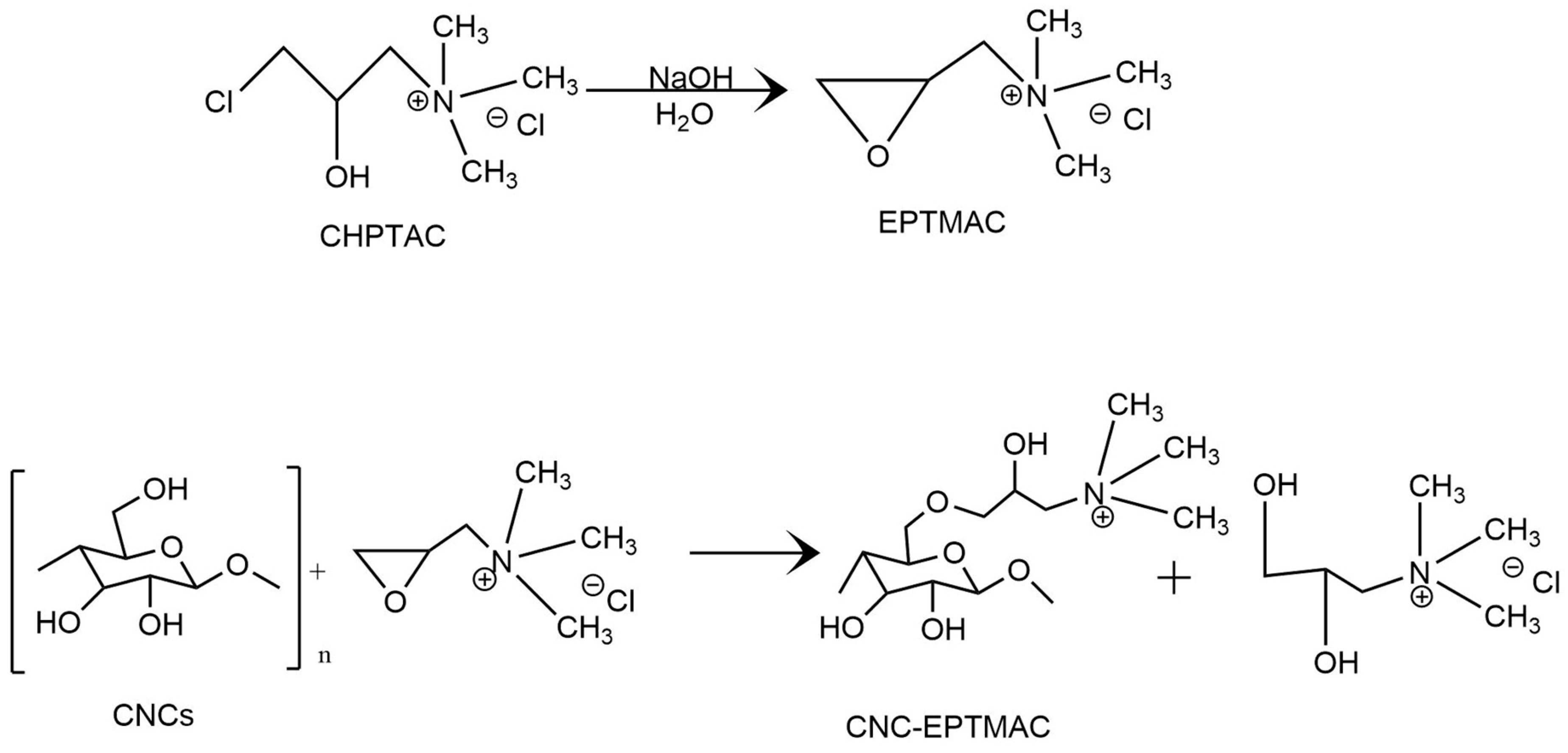
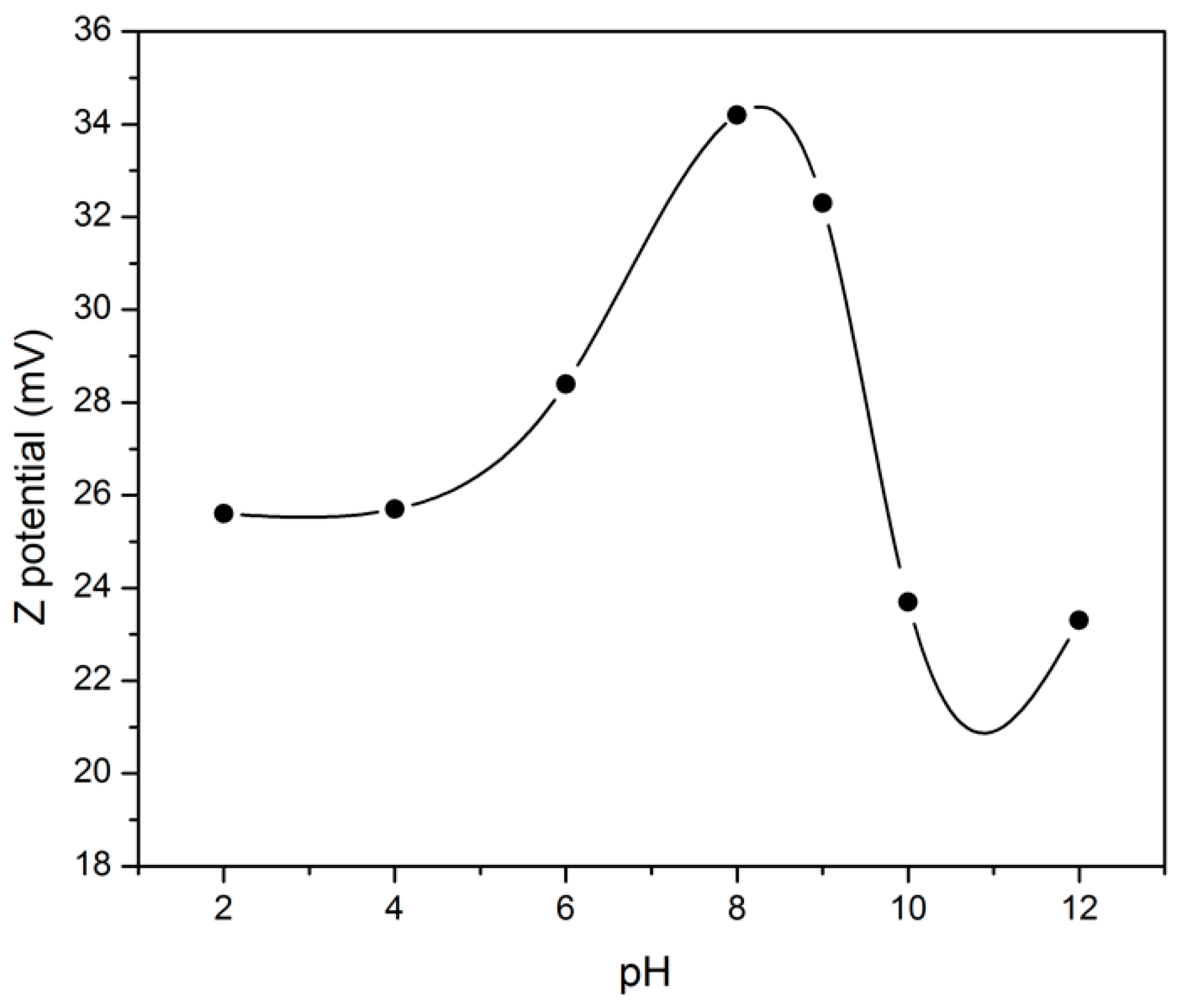
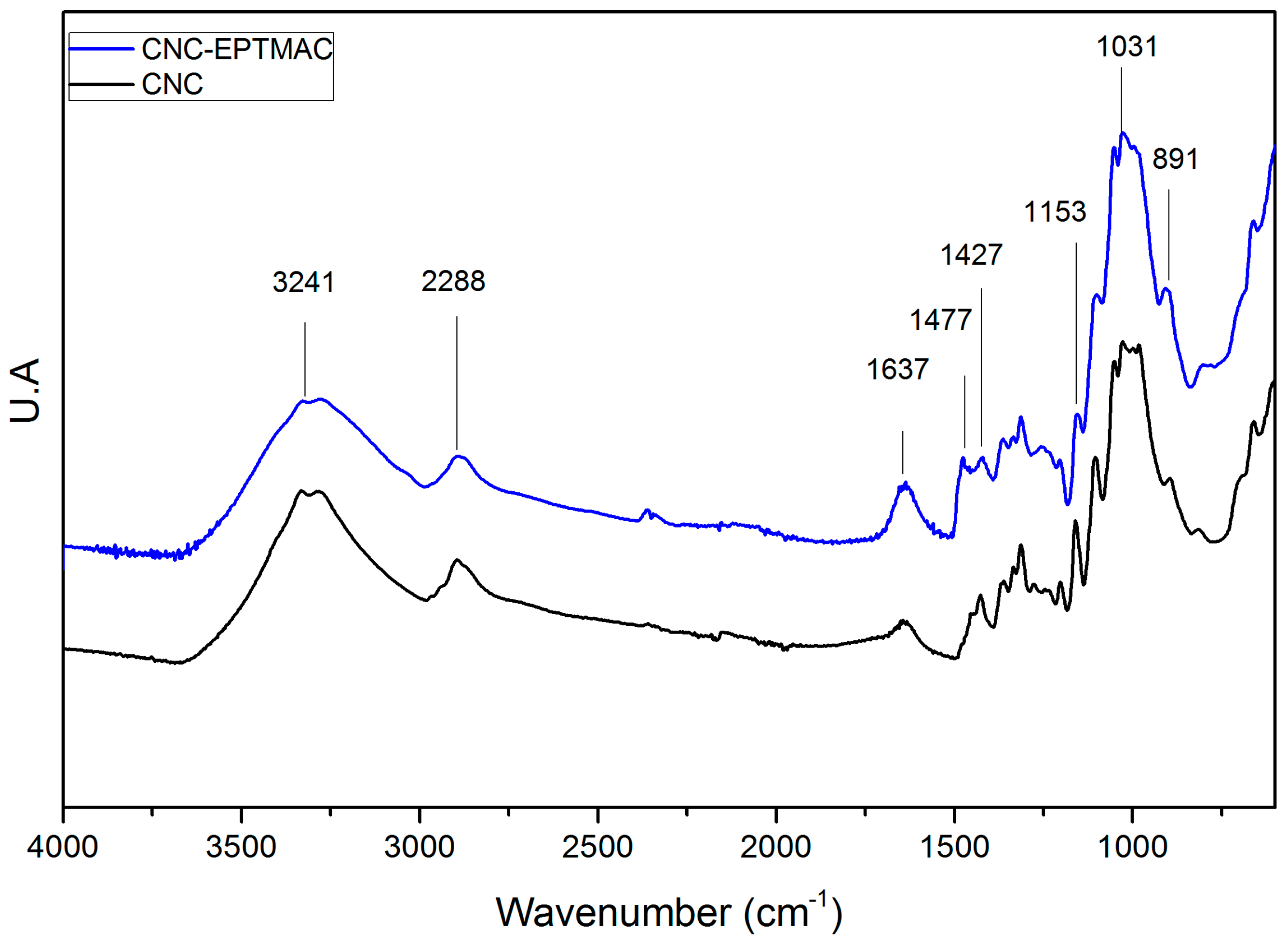

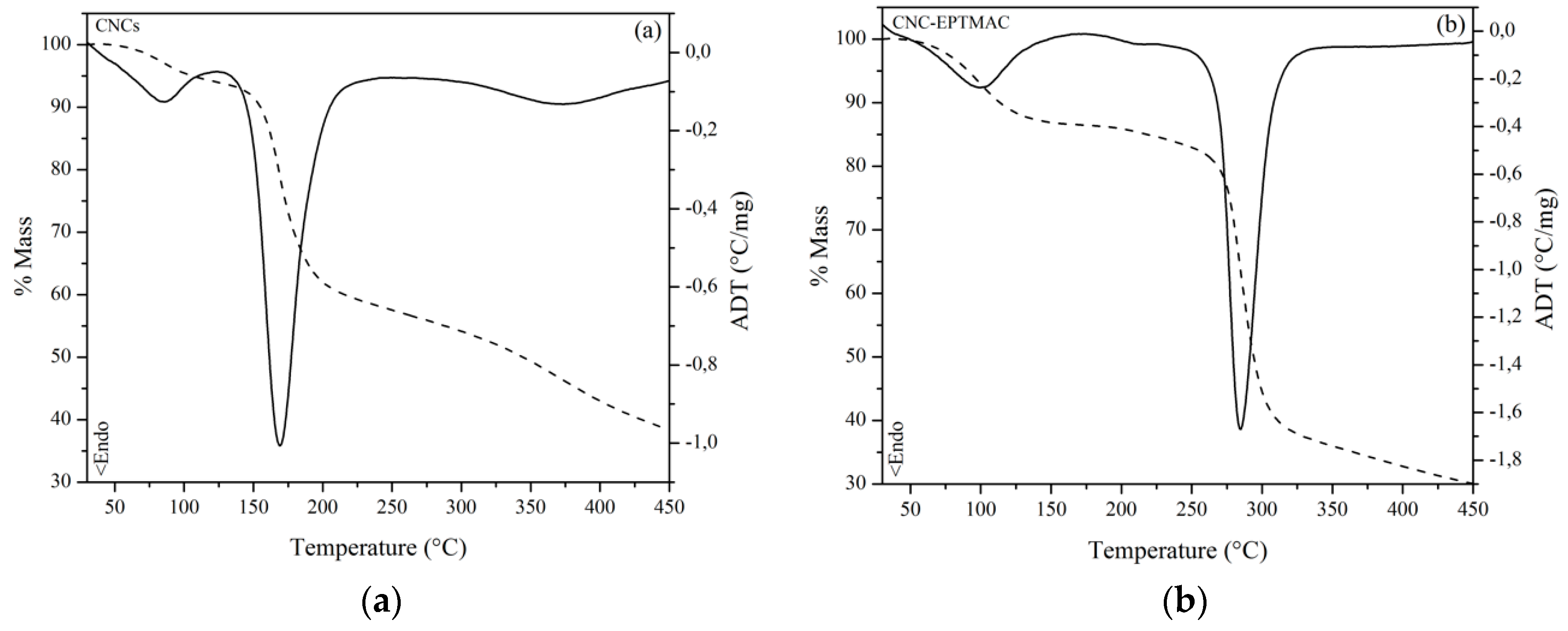

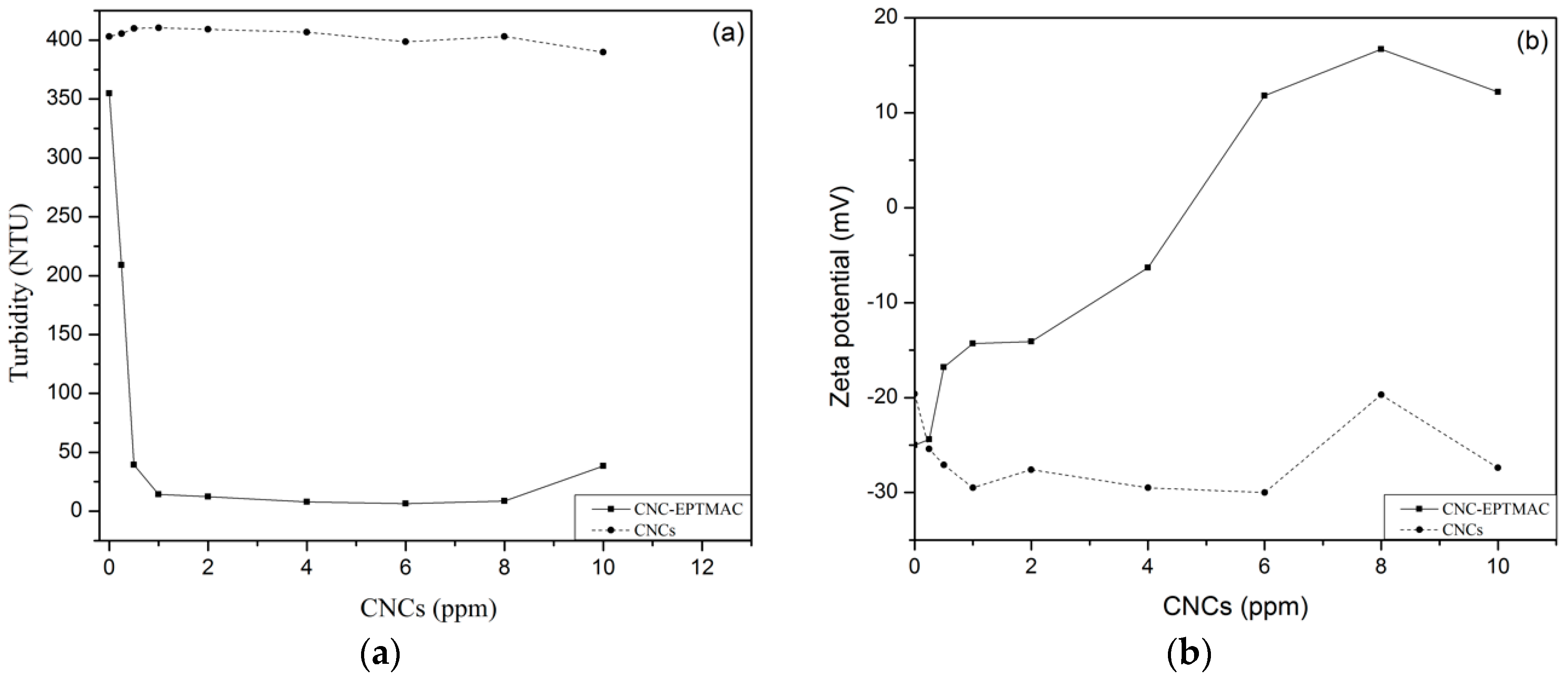
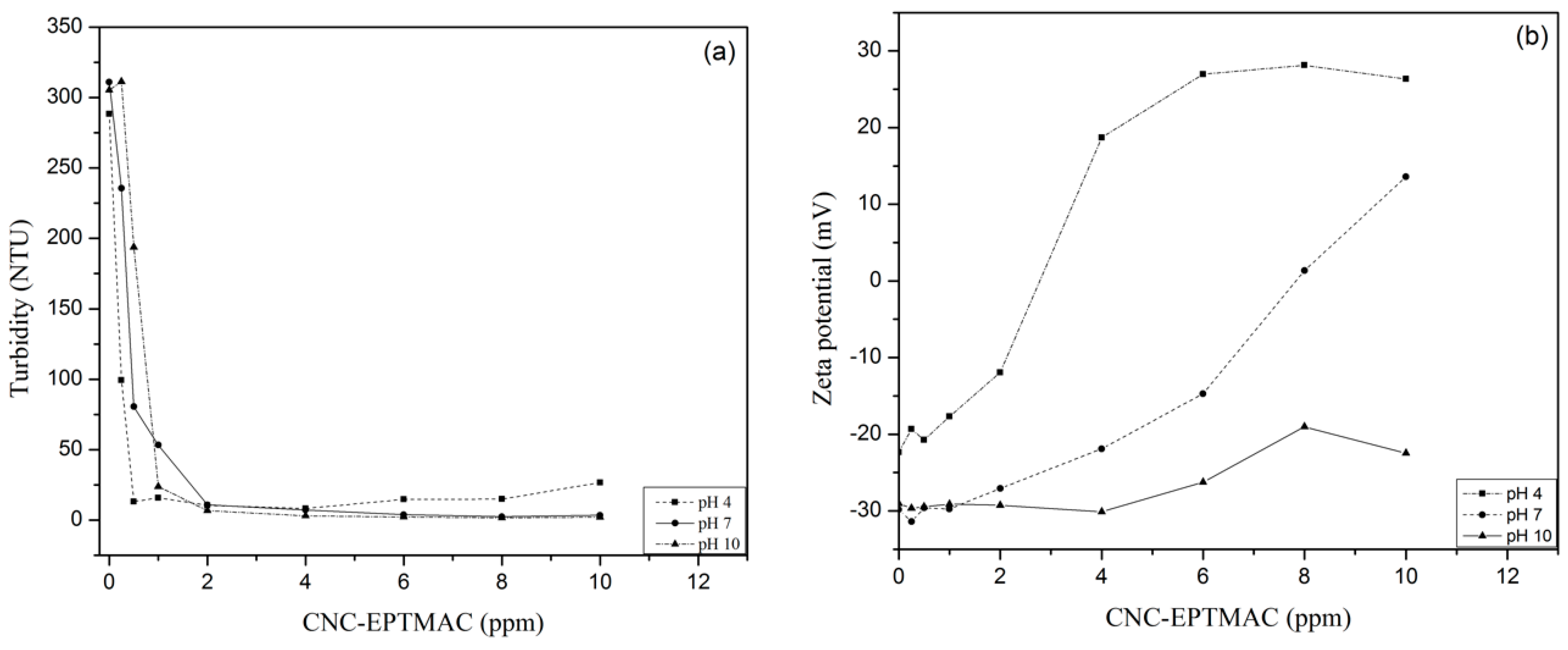


| Time (h) | Molar Ratio 1 | Zeta Potential (mV) | Nitrogen (%) | DS 2 | Size (d.nm) | PdI 3 |
|---|---|---|---|---|---|---|
| 4 | 6 | 33 ± 1.1 | 1.10 | 0.16 | 242.5 | 0.2 |
| 4 | 9 | 36.6 ± 0.2 | 1.33 | 0.21 | 235.7 | 0.2 |
| 4 | 12 | 40.4 ± 0.7 | 1.43 | 0.23 | 305.8 | 0.3 |
| 8 | 6 | 33.1 ± 0.1 | 1.11 | 0.17 | 247.2 | 0.2 |
| 8 | 9 | 37.6 ± 0.5 | 1.50 | 0.25 | 221.7 | 0.2 |
| 8 | 12 | 40.1 ± 1.3 | 1.45 | 0.24 | 234.7 | 0.2 |
| 24 | 6 | 33.8 ± 1.2 | 1.14 | 0.17 | 221.1 | 0.2 |
| 24 | 9 | 36.0 ± 1.0 | 1.90 | 0.36 | 203.5 | 0.2 |
| 24 | 12 | 38.8 ± 1.0 | 1.78 | 0.32 | 300.7 | 0.2 |
| CNCs | 0 | −33 ± 2.1 | 0.00 | 0.00 | 113.7 | 0.4 |
| Sample | * 1 Tdi (°C) | 2 Tdm (°C) | 3 Tdf (°C) | Residual Mass (%) |
|---|---|---|---|---|
| CNCs | 150 | 250 | 450 | 38.37 |
| CNC-EPTMAC | 178 | 320 | 450 | 30.03 |
© 2019 by the authors. Licensee MDPI, Basel, Switzerland. This article is an open access article distributed under the terms and conditions of the Creative Commons Attribution (CC BY) license (http://creativecommons.org/licenses/by/4.0/).
Share and Cite
Morantes, D.; Muñoz, E.; Kam, D.; Shoseyov, O. Highly Charged Cellulose Nanocrystals Applied as A Water Treatment Flocculant. Nanomaterials 2019, 9, 272. https://doi.org/10.3390/nano9020272
Morantes D, Muñoz E, Kam D, Shoseyov O. Highly Charged Cellulose Nanocrystals Applied as A Water Treatment Flocculant. Nanomaterials. 2019; 9(2):272. https://doi.org/10.3390/nano9020272
Chicago/Turabian StyleMorantes, Dana, Efrén Muñoz, Doron Kam, and Oded Shoseyov. 2019. "Highly Charged Cellulose Nanocrystals Applied as A Water Treatment Flocculant" Nanomaterials 9, no. 2: 272. https://doi.org/10.3390/nano9020272





